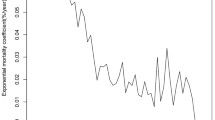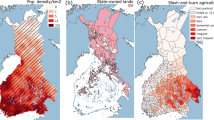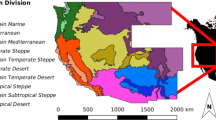Abstract
Many forest population processes operate over long time periods and large areas, at scales which are difficult to study. Concentration on localized forest decline in one place and at one time may obscure this temporal landscape context. However, the effects on forest structure and composition of recent manmade environmental changes cannot be assessed unless the scales of natural demographic processes occurring in forest are first understood (Mueller- Dombois 1986, 1987, 1988).
Access this chapter
Tax calculation will be finalised at checkout
Purchases are for personal use only
Preview
Unable to display preview. Download preview PDF.
Similar content being viewed by others
References
Ahmed M, Ogden J (1987) Population dynamics of the emergent conifer Agathis australis in New Zealand. (1) Population structures and tree growth rates in mature forest. N Z J Bot 25:231–242
Atkinson IAE (1981) Vegetation map of Tongariro National Park, North Island, New Zealand 1:50000. New Zealand Department of Scientific and Industrial Research, Wellington.
Atkinson IAE (1983) Beech forests of Tongariro National Park. In: Silvester WB, Watt V (eds) The future of Tongariro National Park beech forests. Department of Lands and Survey, Wellington, pp 19–23
Clarkson BD (1990) A review of vegetation development following recent (<450 years) volcanic disturbance in North Island, New Zealand. N Z J Ecol 14:59–71
Cockayne L (1908) Report of a botanical survey of the Tongariro National Park. Government Printer, Wellington
Druitt DG, Enright NJ, Ogden J (1990) Altitudinal zonation in the montane forest belt, Mt. Hauahungatahi. North Island, New Zealand. J Biogeog 17:205–220
Gabites I (1986) Roots of fire. A guide to the plant ecology of Tongariro National Park. Tongariro Natural History Society, PO Box 2421, Wellington, New Zealand
Gerrish G (1988) An explanation of natural forest dieback based on the “pipe model” analogy. Geo Journal 17:295–299
Grant PJ (1984) Drought effects on high altitude forests, Ruahine Range, North Island, New Zealand. N Z J Bot 22:15–27
Halle F, Oldeman RAA, Tomlinson PB (1978) Tropical trees and forests: an architectural analysis. Springer Berlin Heidelberg New York
Jacobi JD, Gerrish G, Mueller-Dombois D (1983) ‘Öhi’a dieback in Hawai’i: vegetation changes in permanent plots. Pac Sci 37:327–337
Jane GT, Green TGA (1983) Episodic forest mortality in the Kaimai Ranges, North Island, New Zealand. N Z J Bot 21:21–31
Koyahma T (1988) Etiology of “Shimagare” dieback and regeneration in subalpine Abies forests of Japan. Geo Journal 17:201–208
Kuroiwa S (1960) Intraspecific competition in artificial sunflower communities. Bot Mag Tokyo 73:165–174
Lusk CH (1989) Age structure and dynamics of podocarp/broadleaved forest in Tongariro National Park. PhD Thesis, University of Auckland, Auckland, New Zealand
Lusk CH, Ogden J Age structure and dynamics of a podocarp/broadleaf forest in Tongariro National Park, New Zealand, J Ecol (in press)
McGlone MS (1983) Polynesian deforestation of New Zealand: a preliminary synthesis. Archaeol Oceania 18:11–25
Mueller-Dombois D (1980) The ‘öhi’a dieback phenomenon in the Hawaiian rain forest. In: Cairns J Jr (ed) The recovery process in damaged ecosystems. Ann Arbor Sci Pubi, Ann Arbor, pp 153–161
Mueller-Dombois D (1985) ‘Ohi’a dieback in Hawai’i: 1984 synthesis and evaluation. Pac Sci 39:150–170
Mueller-Dombois D (1986) Perspectives for an etiology of stand-level dieback. Annu Rev Ecol Syst 17:221–243
Mueller-Dombois D (1987) Natural dieback in forests. Bioscience 37:575–583
Mueller-Dombois D (1988) Towards a unifying theory for stand-level dieback. Geo Journal 17:249–251
Ogden J (1985a) Past, present and future: studies on the population dynamics of some long-lived trees. In: White J (ed) Studies on plant demography. A Festschrift for John L Harper. Academic Press, London, pp 3–16
Ogden J (1985b) An introduction to plant demography with special reference to New Zealand trees. NZ J Bot 23:751–772
Ogden J (1988) Forest dynamics and stand-level dieback in New Zealand’s Nothofagus forests. Geo Journal 17:225–230
Ogden J, Fordham RA, Pilkington S, Serra RG (1991) Forest gap formation and closure along an altitudinal gradient in Tongariro National Park, New Zealand. J Veg Sci 2:165–172
Palmer JG, Ogden J, Manning M (1993) A dendrochronologically calibrated radiocarbon date for the Taupo eruption, New Zealand. Radiocarbon (in press)
Phipps RL (1982) Comments on interpretation of climatic information from tree rings, eastern North America. Tree-Ring Bull 42:11–22
Shaw WB (1983) Tropical cyclones: determinants of pattern and structure in New Zealand’s indigenous forests. Pac Sci 37:405–414
Silvester WB, Watt V (1983) The future of Tongariro National Park beech forests. Department of Lands and Survey, Wellington (National Park Series 24. ISSN 0110–2060)
Skipworth JP (1983) Canopy dieback in a New Zealand mountain beech forest Pac Sci 37:391–395
Sprugel DG (1976) Dynamic structure of wave regenerated Abies balsamea forests in the northeastern United States. J Ecol 64:889–911
Steel MG (1989) Mountain beech forest on Mount Ruapehu: dynamics, disturbance and dieback. PhD Thesis, University of Auckland, Auckland, New Zealand
Topping (1973) Tephrostratigraphy and chronology of the Late Quaternary eruptives from the Tongariro volcanic centre, New Zealand. N Z J Geol Geophys 16:397–423
Wardle J (1970) The ecology of Nothofagus solandri. N Z J Bot 8:494–646
Wardle J (1983) Disturbance and the ecology of beeches with emphasis on mountain beech. In: Silvester WB, Watt V (eds) The future of the Tongariro National Park beech forests. Department of Lands and Survey, Wellington, pp 13–18
Wardle JA, Allen RB (1983) Dieback in New Zealand Nothofagus forests. Pac Sci 37:397–404
Weller DE (1987) A reevaluation of the —3/2 power rule of plant self-thinning. Ecol Monogr 57:23–43
Westoby M (1984) The self-thinning rule. Adv Ecol Res 14:167–225
White J (1985) The thinning rule and its application to mixtures of plant populations. In: White J (ed) Studies on plant demography. A Festschrift for John L Harper. Academic Press New York, pp 291–309
Yoda K, Kira T, Ogawa H, Hozumi H (1963) Self thinning in overcrowded pure stands under cultivated and natural conditions. J Inst Polytech Osaka City Univ Ser D 14:107–129
Author information
Authors and Affiliations
Editor information
Editors and Affiliations
Rights and permissions
Copyright information
© 1993 Springer-Verlag Berlin Heidelberg
About this chapter
Cite this chapter
Ogden, J., Lusk, C.H., Steel, M.G. (1993). Episodic Mortality, Forest Decline and Diversity in a Dynamic Landscape: Tongariro National Park, New Zealand. In: Huettl, R.F., Mueller-Dombois, D. (eds) Forest Decline in the Atlantic and Pacific Region. Springer, Berlin, Heidelberg. https://doi.org/10.1007/978-3-642-76995-5_20
Download citation
DOI: https://doi.org/10.1007/978-3-642-76995-5_20
Publisher Name: Springer, Berlin, Heidelberg
Print ISBN: 978-3-642-76997-9
Online ISBN: 978-3-642-76995-5
eBook Packages: Springer Book Archive




